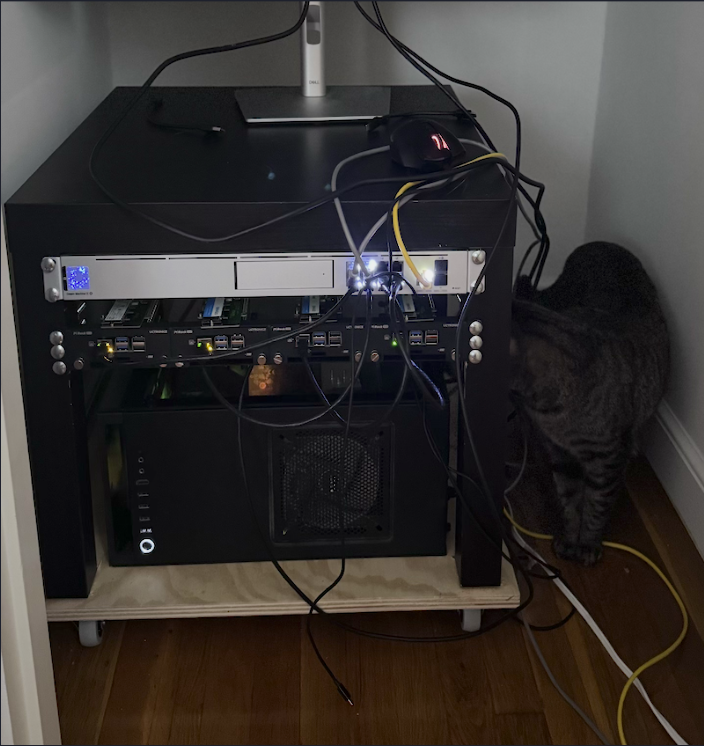Hello, World!

Purpose⌗
Welcome to my corner of the internet! I’m Moose—a cybersecurity analyst by day, a homelab tinkerer by night, and a perpetual learner with a dash of ADHD-induced hyperfixation. If you’ve ever spun up a Docker container purely to see if you could, or spent a Sunday rewiring your network only to tear it all down and start again, you’ll fit right in.
My intended audience is pretty narrow: me, my girlfriend, and maybe a few Googlers or Redditors seeking homelab inspiration. Yet, writing everything down is also an exercise in self-care. I deal with anxiety and depression as part of my day-to-day reality. I’m not a mental health professional, and this blog isn’t intended to replace therapy—but I find that documenting my homelab progress (and setbacks) provides a sense of structure that’s both cathartic and practical.
Over the years, I’ve cycled through countless homelab setups. My architecture has shifted as frequently as my interests: from a full-on Cisco lab for CCNA studies to a sprawling Kali Linux environment when I dove into cybersecurity. Once I’m comfortable with a project, I inevitably tear it down, store it in the dusty corners of my memory, and move on. Then—like clockwork—six months later I need the exact same environment and have zero documentation to show for it.
Hence, this blog: a living archive of my experiments and knowledge. If you’re here for the ride, buckle up and enjoy the chaos.
And then…⌗
It never fails. Six months down the line, I realize I need to spin up the environment I just nuked. My old bookmarks are gone. The invaluable Reddit thread from 2021 is MIA. And I’m left asking myself: Why didn’t I write this down?
So I’ve decided to make a change. I’m going all-in on Infrastructure as Code (IaC). No more half-baked Docker configs scattered across random servers. No more relying on muscle memory. It’s time to build a systematic approach that lets me tear down and rebuild environments at will, while actually learning in the process.
Enter… Kubernetes⌗
One day, a Christian Lempa video about deploying K3s on Raspberry Pis popped into my feed. I’ve worked with Kubernetes off-and-on using managed services like AKS or GKE, but never really got hands-on with the plumbing. Why not use a Pi cluster to learn the underpinnings?
I decided to spend a Sunday at Micro Center to pick up hardware for a brand-new everything-must-go approach to homelabbing.
The Haul:⌗
- 4× Raspberry Pi 5 8GB
- 4× GeekPi N04 M.2 NVMe to PCIe HATs
(I’ve had too many SD card catastrophes in the past—fool me once, shame on you; fool me twice…not happening!) - 4× Waveshare PoE HATs
(So I can run them headless in a closet without dealing with a power brick tangle.) - 4× Geekworm PCIe Ribbon Cables
(Needed extra length to stack the SSD and PoE HAT—turns out, I was right.) - 1× 19" 1U Rack Mount for Raspberry Pi
The Plan:⌗
My goal is to learn how to manage infrastructure at scale while simultaneously keeping track of my mental well-being. I want to be able to spin up a fully-functional environment, tear it down, and then replicate it again a week (or six months) later—without losing my mind.
Armed with:
- An aging but trusty gaming PC loaded with a few SSDs,
- A cluster of shiny new Raspberry Pis, and
- A Ubiquiti Dream Machine Special Edition,
I’m ready to transform this blog into my living “ops log.” If it goes right, I’ll detail the steps. If it blows up in my face, I’ll detail the steps. My girlfriend and I also plan to host some personal services on the Pi cluster, so that alone will push me to keep everything stable.
If you’ve made it this far (looking at you, Lianna, Ralph, maybe Myrtle), I hope you’ll stick around for the ride—whether you’re here for the tech tips, a glimpse at my messy mental process, or simply the occasional schadenfreude when something catches fire (figuratively…hopefully).
Until next time, homelab on and take care of yourselves.